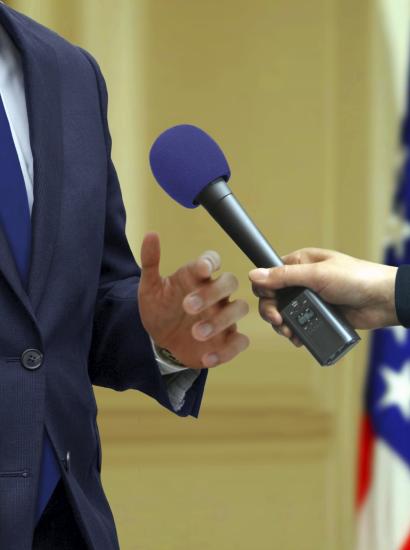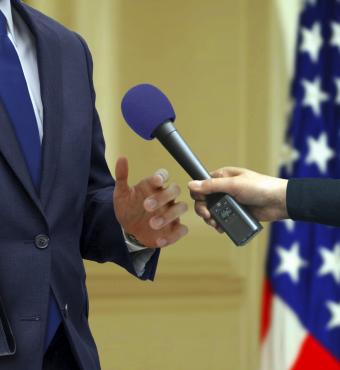- Politics, Institutions, and Public Opinion
- State & Local
- California
Physique isn’t the only dramatic difference between Arnold Schwarzenegger and Jerry Brown, the last two California governors before Gavin Newsom.
When it came to their approach to public communications and work with the press corps as governors, Brown embraced scarcity, was often unscripted, and spurned choreography. Perhaps it was just the mind-set of an aging philosopher-king who no longer had the ambitions of his younger self, but Brown could have done much more to tell Californians about how he was governing.
Schwarzenegger, by contrast, flexed the power of being one of the most famous men in the world, bringing international correspondents to Sacramento to cover his every move. As his communications chief, my responsibility was to see to it that we took full advantage of the megaphone that his fame gave us, planning weekly or twice-weekly public events. The events drove a narrative that was carefully planned and supported the governor’s policy and political objectives.
Now arrives in the governor’s office Gavin Newsom, an ambitious and articulate politician with Hollywood good looks and an authoritative gravelly voice that commands attention. Newsom will almost certainly reengage Californians with a more aggressive communications effort than Brown, who underutilized the capabilities of his very good press aide Evan Westrup and his team.
So, in the spirit of believing that great communication by officeholders is a virtue that serves democracy well, here are some principles to consider and tactical advice from a battle-worn hack that will help Newsom give Californians a more engaged interest in the work of their state government.
Focus on the arc of your narrative. Governor Newsom, you certainly have a policy agenda you intend to implement and highlight. But please avoid the temptation to feed too many story lines at once. Keep it focused.
This is not as easy as it would seem. There will be various constituencies and stakeholders, both within and outside the government, who will be anxious for you to douse attention upon their issue.
Just as you have been given plentiful advice on how important the word “no” will be to the Legislature, it will also be a very important word to exercise in order to maintain control of your own public narrative. Appropriate your voice judiciously and with intentionality. Every public event, speech, and media event should have a purpose that serves your objectives.
Staff up the communications operation. Governor, the beauty of a well-staffed coms operation is that not only is it an effective way to proactively advance your message, but the coms shop is also on the frontline of staying atop of the sprawling government you now command.
In my experience, it was not uncommon for the sleuths in the coms operation to be the early detectors of issues arising across the vast bureaucracy. Remember, the Department of Motor Vehicles is now yours, and there is always some corner of government lumbering toward a potential crisis.
Feed the press corps. With the advent of a robust CALmatters bureau and Politico’s recent commitment to open a State Capitol bureau, hopefully we’ve seen the low point of the media’s recess from statehouse coverage. While we may never again see the level of coverage that marked Schwarzenegger’s tenure, we’re nonetheless hopefully in a revival of coverage.
Governor, you should feed the beast and help it succeed. It’s a symbiotic relationship. How you do that can take many forms. Consider frequent press conferences, and do impromptu end-of-day press avails when there’s news to relate. Every week, pick a few press calls off the press secretary’s desk to return yourself.
However you do it, engage with the media. Give them content and drive your own message at the same time, and frankly demonstrate better civics than Jerry Brown did and certainly better than what we see from the White House.
Take it on the road. You’re a new governor with a regional base. Broaden it. Give Los Angeles television stations three to five opportunities a month to show you on camera doing something in Southern California.
The Central Valley is constantly neglected (and knows it). Show up there. Go to Fresno monthly. Make news with the agricultural industry. Focus on Valley issues. Stay and have dinner in their restaurants and invite the local press to capture it all. You’ll be a natural at this. Show them that the slick former San Francisco mayor is not a coastal metrosexual. He’s now their governor—and in their corner.
Develop your own media channels, and pioneer new government openness. Governor, you’ve been a true champion of open government (for example, cochairing Digital Democracy’s initiative to provide a user-friendly platform to watch legislative hearings).
Now, not all deliberations in a governor’s office should be publicly aired. However, social media platforms allow you to bring Californians inside your office. You can debrief them on important meetings, introduce them to agency secretaries, and show your administration at work. Use these channels to provide video of your meetings and events around the state.
This is not the future—it’s the present of how politicians can and should be communicating. There just aren’t many elected officials doing it well yet. Maybe they’re too timid. You’re not. Break through as being known as the country’s transparent governor.
By the way, the same tactics translate to Iowa and New Hampshire, so hone the skills now as California’s governor.
Own the authenticity test. Governor, the beauty of owning your own channels is that it allows you to transmit authenticity. That’s the principle of successful social media.
With Governor Schwarzenegger, we choreographed cinematic events. That suited his strengths and allowed voters to see him as they were used to seeing him.
Californians haven’t decided yet if you’re an overproduced and overhandled slick politician, or an authentic guy in whom they can build trust. Don’t let Beto O’Rourke be the guy they’re buzzing about; make it you.
Governor, if successful with your coms operation, you’ll know it. The obvious markers will be strong approval ratings and a healthy public awareness of your initiatives.
But beyond that, you’ll be able to see it in press coverage and social media interaction. If the cumulative coverage shows you on the offensive, then you’re succeeding. If legislators are elbowing their way into your photo ops, you’re succeeding. If you’re getting kudos for transparency and atypical open government, you’re succeeding.
Good luck.
Rob Stutzman is president of Stutzman Public Affairs, LLC and former deputy chief of staff for communications for Governor Arnold Schwarzenegger. He also previously served as communications director for the California Attorney General’s office.
















